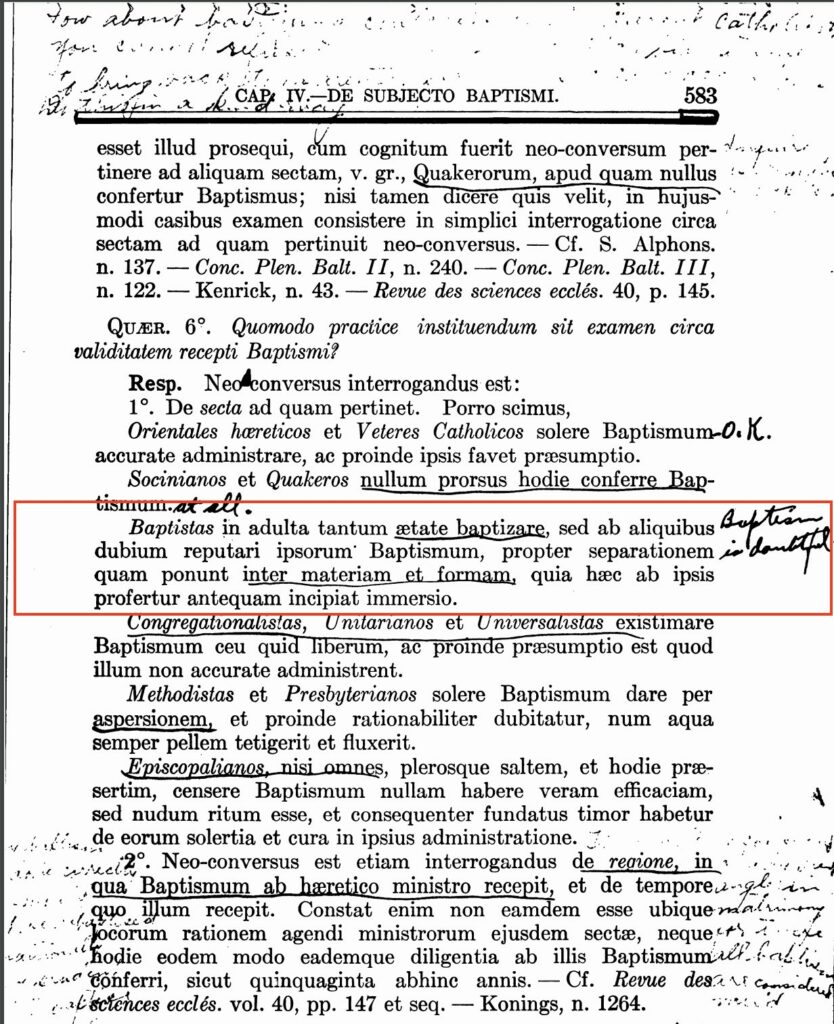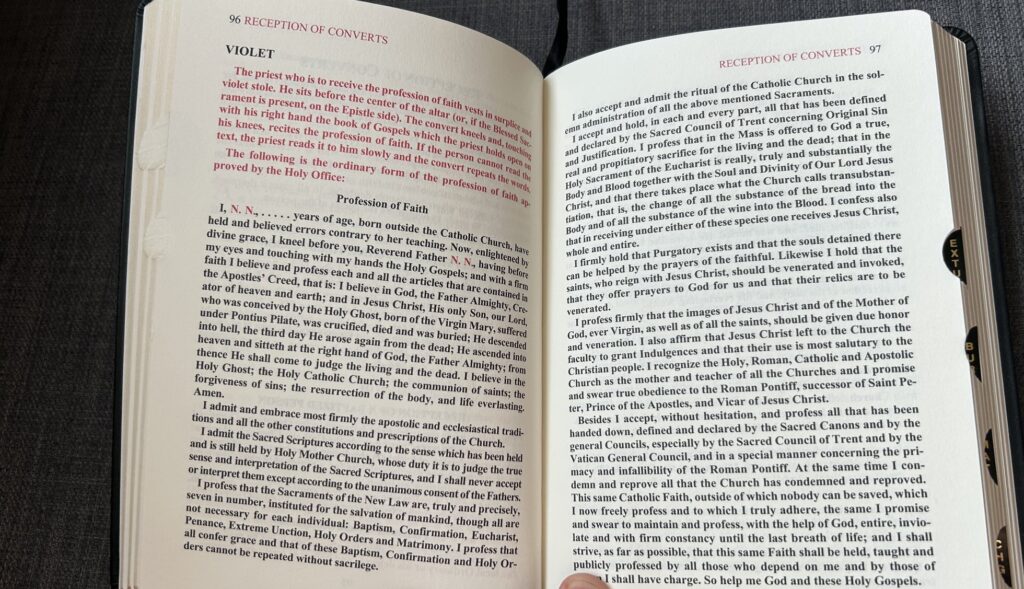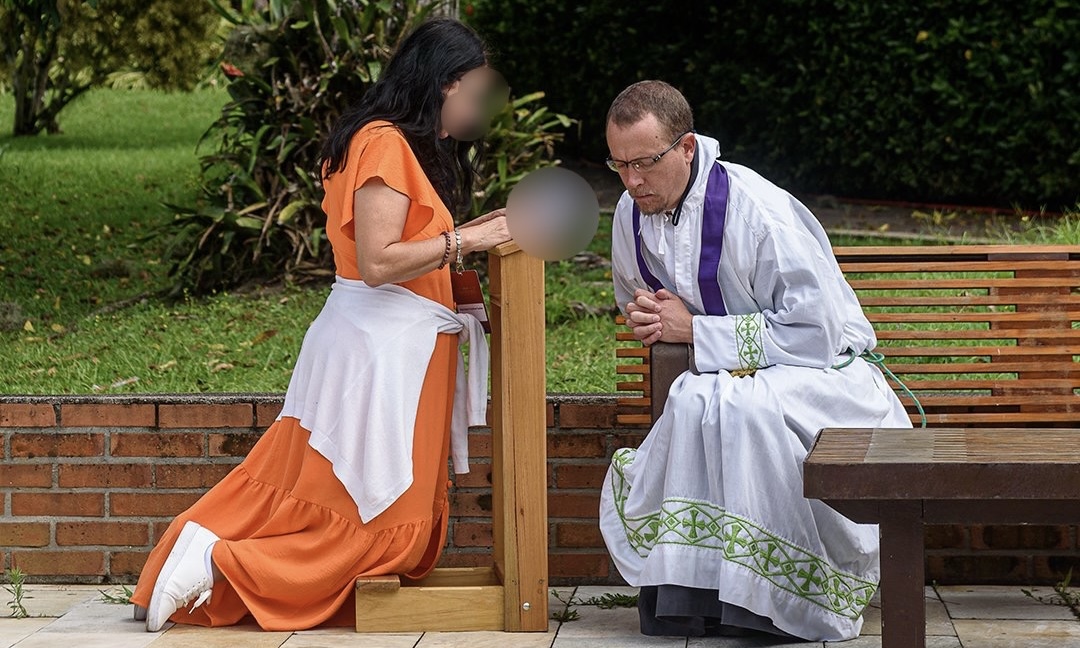As we will see below, the order of operations is: 1) Accept Christ. 2) Abjure past errors and make a profession of the Catholic Faith. 3) Actual (or conditional baptism.) 4) Lifetime confession. 5) All other sacraments.
Recently, God has been using me to bring some older folks into the Catholic Church. One of these was the mother of a friend of mine who had been raised Lutheran. After her daughter and her granddaughter and I visited her in the nursing home, she decided to go from Lutheran to Catholic on her deathbed. At the time she made this decision, she had almost no dementia or senility, so no one can accuse us of making a “gullible conversion.” In other words, she entered the Church with her full consent of the will.
What is the key to such a conversion?
The traditionalist priest will lovingly explain the faith to a potential convert. He will re-explain what a Lutheran already knows—that Jesus Christ loves her infinitely and that He died and rose for her. But then the traditional priest will go on to explain why Christ can have only One Spouse, namely, the Catholic Church. He may go on to explain why Christ established this for the salvation of as many people as possible, with all seven sacraments. Neither will the traditionalist priest look for a “gullible conversion,” nor will he make a potential-convert memorize the whole Catechism of Trent to prove entrance into the Catholic Church.
The traditional priest will also approach the sacraments in a very different way than the modernist priest. A liberal modernist might just anoint such a convert. A conservative modernist might add confession onto the anointing. A modernist priest might hesitatingly grant a conditional baptism to a Mormon or Jehovah’s Witness entering the Catholic Church on their deathbed.
But before Vatican II, every Protestant convert entering the Catholic Church received a conditional baptism, whether at the parish or on the deathbed. This wasn’t because we necessarily believed the Protestant’s faith in the Trinity was heretical.

Rather, there were often small mistakes to matter and form that could have prevented validity in the original Protestant baptism. For example, an old manual I read in Latin said that Baptists often separated matter and form in baptism. In this case, the three dunks were sometimes done separately from naming the three persons of the Trinity. The Church deemed this might make it invalid. And might isn’t good enough for salvation. Therefore, the Church traditionally required a conditional baptism for a Baptist entering the Catholic Church (either at the parish with sufficient time for full catechesis or in an emergency with limited time.)
And yes, I know this is a show-stopper for any modernist priest reading this blog. But this is the perennial teaching of the Catholic Church, as I will prove below.
In the old parish ritual and official sacramental books, all Protestant converts (not just Mormons or Jehovah’s Witnesses) received a conditional baptism coming into the Catholic Church. Again, this is shocking to any priest who has gone through the post-Vatican II seminary system. But why was this practice changed only as late as the 1960s and 1970s? I have searched and searched but the only real reason I can come up with is political, not theological. Basically, the hierarchy stopped conditionally baptizing Protestant converts only because it looked bad for “ecumenical relations.”
But modernists couch this under the theological pretext of having only one baptism for the forgiveness of sins—be it either Catholic or Protestant. (I too did this at one point, until I discovered that such practices went against the traditional Magisterium of the Catholic Church.)
Will the traditional priest then request the convert make a lifetime confession? Yes, unless the new convert received not a conditional baptism but only their actual baptism on their death bed. In other words, a Hindu or Jewish convert whom I baptize on his death bed will need no lifetime (or general) confession. This is because baptism obviously covers all their sins. However, if I give a conditional baptism to a Protestant, I still encourage them to make a lifetime confession. If they are actively dying, just walk them through the most common 15 mortal sins.
Why do I make them do a confession if they just received a conditional baptism ten minutes ago? Because maybe the original Protestant baptism was valid.
Now, I know some of you are thinking “maybe” is not reason enough to thrust your scrupulosity upon some poor dying person. But my reply to your lack of faith is simple: This is the practice of the Catholic Church for every century before Vatican II. Every priest from the Council of Trent all the way until Vatican II would have been told to grant Protestant converts both a conditional baptism and a general confession within the same hour of their conversion in an emergency. The Church always had a medical view (not just a legalistic view) in her solicitude for the salvation of souls.
But for Catholics who think Lutherans have just as much of a chance at salvation as Catholics, well, this entire blog is going to read as antiquated or Jansenistic. Unfortunately, such ignorant people are not only rejecting the second millennium of Catholicism. They’re also rejecting the first millennium of Catholicism. What I’m typing in this blog is the mind of the Church forever, not just something a few “rigorists” might want to do in the 21st century.

The other big difference for a traditional priest effecting the reception of converts into the Catholic Church is that our old rite Parish Ritual book (see picture above) demands that any new convert abjure past errors (usually Protestantism but sometimes Islam, Hinduism or Judaism) in his or her acceptance of Christ and the Catholic Faith. Again, due to false-ecumenism, this practice was also mysteriously tanked in the 1960s to make people feel better.
As if feelings were the only goal of a conversion, I do find that converts really do feel better abjuring their past errors. Then, they make a long statement of accepting every tenet of the Catholic Faith. There’s a long version and short version, but in both cases, it’s basically a very long Creed.
One version of the Profession of Faith is below in italics. I was brought to tears hearing one of my recent converts say the following out loud holding a Bible on what became her holy death bed:
I, N.N., _____ years of age, born outside the Catholic Church, have held and
believed errors contrary to her teaching. Now, enlightened by divine grace, I
kneel before you, Reverend Father _____________, having before my eyes and
touching with my hand the Holy Gospels; and with a firm faith I believe and
profess each and all the articles contained in the Apostles’ Creed, that is: I
believe in God, the Father Almighty, Creator of Heaven and Earth; and in Jesus
Christ, His only Son, our Lord, Who was conceived by the Holy Ghost, born of
the Virgin Mary, suffered under Pontius Pilate, was crucified, died, and was
buried; He descended into hell, the third day He arose again from the dead; He
ascended into heaven and sitteth at the right hand of God, the Father
Almighty; from thence He shall come to judge the living and the dead. I believe
in the Holy Ghost; the holy Catholic Church; the communion of saints; the
forgiveness of sins; the resurrection of the body, and life everlasting. Amen.
I admit and embrace most firmly the apostolic and ecclesiastical traditions
and all the other constitutions and prescriptions of the Church.
I admit the Sacred Scriptures according to the sense which has been held
and which is still held by Holy Mother Church, whose duty it is to judge the
true sense and interpretation of the Sacred Scriptures, and I shall never accept
or interpret them except according to the unanimous consent of the Fathers.
I profess that the Sacraments of the New Law are, truly and precisely, seven
in number, instituted for the salvation of mankind, though all are not necessary
for each individual: Baptism, Confirmation, Eucharist, Penance, Extreme
Unction, Holy Orders, and Matrimony. I profess that all confer grace, and that
of these Baptism, Confirmation, and Holy Orders cannot be repeated without
sacrilege.
I also accept and admit the ritual of the Catholic Church in the solemn
administration of all the above mentioned Sacraments.
I accept and hold, in each and every part, all that has been defined and
declared by the Sacred Council of Trent concerning original sin and
justification. I profess that in the Mass is offered to God a true, real, and
propitiatory sacrifice for the living and the dead; that in the Holy Sacrifice of
the Eucharist there is really, truly, and substantially the Body and Blood
together with the Soul and Divinity of our Lord Jesus Christ, and that there
takes place what the Church calls transubstantiation, that is, the change of all
the substance of the bread into the Body, and of all the substance of wine into
the Blood. I confess also that in receiving under either of these species, one
receives Jesus Christ, whole and entire.
I firmly hold that Purgatory exists and that the souls detained there can be
helped by the prayers of the faithful. Likewise I hold that the saints, who reign
with Jesus Christ, should be venerated and invoked, that they offer prayers to
God for us and that their relics are to be venerated.
I profess firmly that the images of Jesus Christ and of the Mother of God,
ever Virgin, as well as of all the saints, should be given due honor and
veneration. I also affirm that Jesus Christ left to the Church the faculty to grant
Indulgences, and that their use is most salutary to the Christian people. I
recognize the Holy, Roman, Catholic, and Apostolic Church as the mother and
teacher of all the Churches, and I promise and swear true obedience to the
Roman Pontiff, successor of St. Peter, Prince of the Apostles and Vicar of Jesus
Christ.
Besides I accept, without hesitation, and profess all that has been handed
down, defined, and declared by the Sacred Canons and by the general
Councils, especially by the Sacred Council of Trent and by the Vatican General
Council [the first one] and in a special manner concerning the primacy and infallibility of the
Roman Pontiff. At the same time I condemn and reprove all that the Church
has condemned and reproved. This same Catholic Faith, outside of which
nobody can be saved, which I now freely profess and to which I truly adhere,
the same I promise and swear to maintain and profess, with the help of God,
entire, inviolate, and with firm constancy until the last breath of life; and I shall
strive, as far as possible, that this same Faith shall be held, taught, and publicly
professed by all those who depend on me, and by those of whom I shall have
charge. So help me God and these holy Gospels.
Two days after she said the above statement (repeating each line after me, as her eyesight was bad) I brought her what would become her First—and Last—Holy Communion. I also gave her extreme unction. Two weeks later I confirmed her. She died shortly after that. Please pray for the repose of her soul, as well as the other elderly folks I have been helping approach the Catholic Church over the last couple weeks of my travels.
